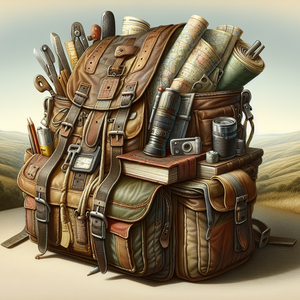The Renaissance of Artisan Professions in Italy

The revival of artisan professions in Italy can be attributed to several key factors.
Appreciation for Handmade Goods
Firstly, there is a growing appreciation for handmade, authentic products among consumers, particularly in an age dominated by mass production. As people seek unique items that tell a story, artisans who preserve traditional techniques are finding a receptive market. For example, the rise of the “slow fashion” movement has led many consumers to favor handcrafted clothing and accessories over mass-produced alternatives.
Sustainable Practices
Another significant factor is the increasing interest in sustainable practices. Many artisans prioritize eco-friendly methods, sourcing materials locally and creating products that are not only beautiful but also sustainable. This aligns with a broader global trend toward sustainability, making artisanal goods appealing to environmentally conscious consumers. Brands like "EcoBottega" are gaining traction for their commitment to sustainable production, showcasing how artisan methods can coalesce with eco-friendly practices.
Digital Platforms
Finally, the rise of social media and e-commerce has provided artisans with a platform to showcase their work and reach a wider audience. Platforms like Instagram and Etsy allow artisans to connect directly with consumers, bypassing traditional retail channels and giving them the opportunity to tell their story. For instance, the Italian leather brand "Il Bisonte" has brilliantly utilized Instagram to promote its handcrafted goods, gaining a loyal following that appreciates both the artistry and the story behind each piece.
Cultural Heritage and Local Economies
The resurgence of artisan professions is not merely an economic phenomenon; it is deeply intertwined with Italy's cultural heritage. Each craft embodies centuries of tradition, skill, and storytelling.
Traditional Techniques
For instance, in Murano, glassblowers continue to create exquisite glass pieces using techniques passed down through generations. The delicate art of glassblowing in Murano has been recognized as an intangible cultural heritage by UNESCO, emphasizing its significance to both local and global communities. Similarly, in Tuscany, leather artisans craft beautiful goods, preserving the age-old techniques that have defined the region for centuries.
Economic Impact
This revival has significant implications for local economies. Artisan shops not only create jobs but also attract tourists eager to experience authentic Italian craftsmanship. For example, the town of San Gimignano has seen a boost in tourism due to its artisanal gelato shops and pottery studios, driving economic growth while enhancing the town's cultural appeal. According to the Italian National Institute of Statistics (ISTAT), artisan businesses in Italy contribute significantly to employment, with over 1.5 million people working in the sector.
Community and Identity
Moreover, local artisans often source materials from nearby suppliers, creating a ripple effect that benefits the entire community. This interconnectedness fosters a sense of pride and identity among residents, as they see their local culture being celebrated and preserved. The revival of traditional crafts not only serves economic purposes but also strengthens community bonds, as locals engage with their heritage.
Adapting to Contemporary Demands
While the revival of artisan professions celebrates tradition, it also requires adaptation to contemporary market demands.
Innovation and Collaboration
Many artisans are embracing innovation by incorporating modern design elements into their work and utilizing digital marketing strategies to reach new customers. For instance, some artisans are collaborating with contemporary designers to create unique, limited-edition products that appeal to younger consumers. The collaboration between ceramic artists and fashion designers in Florence exemplifies this trend, leading to the creation of stylish yet functional products.
Experiential Tourism
Additionally, the rise of experiential tourism has opened new avenues for artisans. Workshops and classes are increasingly popular, allowing tourists to engage directly with artisans and learn the skills behind the crafts. This not only provides an additional revenue stream for artisans but also fosters a deeper appreciation for their work among participants. The “Made in Italy” workshops offer tourists the chance to learn pasta-making, leather crafting, or mosaic art, creating memorable experiences that connect them with Italian culture.
The renaissance of artisan professions in Italy is a vibrant testament to the country's rich cultural heritage and its ability to adapt to changing consumer preferences. As traditional crafts gain popularity among locals and tourists, they are revitalizing local economies and preserving age-old techniques for future generations. This movement represents more than just a trend; it is a profound acknowledgment of the value of craftsmanship and the stories woven into each handmade item. As Italy continues to embrace this artisan revival, it highlights the importance of maintaining a connection to the past while creatively shaping the future. In a world increasingly dominated by uniformity, Italy’s artisans stand as a beacon of individuality, creativity, and cultural pride.
Artisan Leather Craftsman
Local artisan workshops, luxury fashion brands (e.g., Gucci, Prada), independent leather goods boutiques
Core Responsibilities
Design and create handcrafted leather goods, including bags, wallets, and belts, using traditional techniques.
Repair and restore leather items, ensuring quality and longevity.
Collaborate with designers to develop custom pieces that reflect current trends while honoring traditional craftsmanship.
Required Skills
Proficiency in leatherworking tools and techniques, including stitching, tooling, and dyeing.
Strong attention to detail and an artistic eye for design.
Experience with sustainable sourcing practices for materials.
Glassblower
Art studios, galleries, glass manufacturing companies, especially in regions like Murano, Venice
Core Responsibilities
Create unique glass artworks and functional pieces using traditional glassblowing techniques.
Conduct demonstrations and workshops to educate the public about the glassblowing process.
Collaborate with interior designers and artists to produce custom glass installations.
Required Skills
Extensive knowledge of glass properties and heating techniques, as well as safety protocols for working with molten glass.
Creativity and a strong sense of aesthetics to design visually appealing pieces.
Ability to work collaboratively in a team environment, especially in a studio setting.
Artisanal Cheese Maker
Local dairies, artisanal cheese shops, gourmet food producers
Core Responsibilities
Produce a variety of cheeses using traditional methods, emphasizing flavor and quality.
Experiment with local ingredients to create unique cheese profiles that reflect regional tastes.
Manage the aging process and ensure proper storage conditions for optimal cheese development.
Required Skills
In-depth knowledge of dairy science and cheese production techniques, including pasteurization and fermentation.
Strong palate for flavor profiling and a creative approach to product development.
Experience with quality control and food safety standards.
Mosaic Artist
Art studios, community art projects, cultural heritage organizations
Core Responsibilities
Design and create intricate mosaic artworks for public installations, private commissions, and restoration projects.
Source and select materials, including tiles, glass, and stones, that enhance the visual impact of the artwork.
Conduct workshops for community members and tourists to teach mosaic techniques and promote the craft.
Required Skills
Exceptional artistic and design skills, with a strong understanding of color theory and composition.
Proficient in various mosaic techniques, including direct and indirect methods.
Experience in project management and collaboration with architects and designers.
Sustainable Fashion Designer
Eco-conscious fashion brands, artisan cooperatives, independent boutiques
Core Responsibilities
Create clothing and accessories using sustainable materials and ethical production practices, focusing on slow fashion principles.
Conduct research on current trends while integrating traditional craftsmanship techniques into modern designs.
Collaborate with local artisans to promote handmade collections that support the local economy.
Required Skills
Strong design and sewing skills, with an emphasis on pattern making and garment construction.
Knowledge of sustainable materials and practices, including organic fabrics and eco-friendly dyes.
Effective communication skills for collaborating with artisans and marketing products online.


